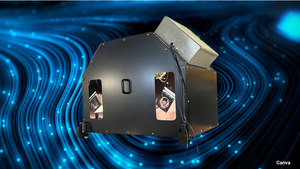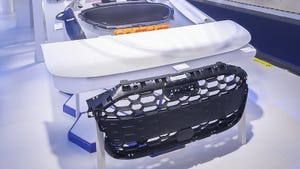Foam injection molding: The search for a better method
March 1, 2004
The advantages conferred by foam injection molding are widely understood and appreciated. However, there are limits to the process. Germany''s Institute for Plastics Processing has developed an alternative method that bears scrutiny.
Aspecial injection molding process like foam injection molding offers many advantages to the processor. Enhanced part properties as well as advantages in the production process are possible. Usually, reduction of shrinkage and warpage or the avoidance of sink marks are possible by using blowing agents. Also, in many cases the cooling phase can be enormously shortened.
This list of favorable properties can be continued further, but there are also disadvantages. The part surface is very often of minimal quality. Also, a drop in mechanical properties can occur, especially when directly substituting a part that has been designed for standard injection molding, without appropriate modifications to the part and the mold. To overcome these problems, an approach, which covers the entire chain of production, is necessary.
Starting with the right choice of the polymer for the application, a suitable blowing agent needs to be chosen for the foam injection molding process (FIM). This can be either a chemical blowing agent or a physical blowing fluid, such as nitrogen or carbon dioxide.
Chemical blowing agents (CBA) consist of the blowing agent itself—for example, citric acid—and a polymeric carrier, which also might include flow-enhancing additives or pigments. The blowing gas is generated during the thermal decomposition of the blowing agent in the plasticating unit. Up to 65% of the blowing agent remains as solid a residue in the polymer melt, where it is used as nucleating agent on the one hand; but on the other hand, it can lead to decomposition of the polymer and/or deposits in the processing machine and in the mold. A clear advantage of chemical blowing agents is the simple volumetric dosage and the possibility to use standard injection molding equipment.
The use of physical blowing fluids (PBF) generally leads to higher degrees of foaming and thus to lower density of the parts. There are no deposits or solid residues remaining in the part, which means that the range of applications of physically blown parts includes food packaging and medical products. Advantages of nitrogen and carbon dioxide compared to other physical blowing fluids (e.g., pentane) are that they are not flammable and non-toxic. But processing PBFs is more demanding of machinery and process control. Further, CBAs tend to achieve better part surfaces since there is a lot of technical experience, and a nucleating agent is already incorporated in their formulation.
Due to late developments in the field of processing physical blowing fluids in injection molding, this process has come into fashion again. In a foam injection process using physical blowing fluids, the preparation of the PBF/melt system is of special importance. A sufficient quantity of fluid has to be evenly dissolved in the melt. But the generated system also needs to be thermally homogeneous. Therefore, injecting and properly mixing the PBF is the second step to success.
Taking a fresh look at foam
Based on earlier developments and past investigation at the Institute of Plastics Processing (IKV; Aachen, Germany), a new concept for injecting the physical blowing fluid has been developed. It consists of a special nozzle, which is designed to be mounted between the plasticating unit and the shut-off nozzle of a conventional injection molding machine. The concept and the prototype of the fluid injection nozzle were first presented at the IKV-Colloquium 2000.
To achieve a homogeneous distribution of the blowing fluid, the diffusion path in the melt has to be as short as possible. Research shows the time necessary for charging the melt can be minimized by shortening the diffusion path. This led to the eventual conclusion that the surface/volume-ratio had to be maximized.
According to this specification, a ring-shaped die design was selected. A torpedo is placed in the center of the melt flow channel (see Figure 1). Both the surface of the torpedo and the outer surface of the melt flow channel are made from porous—and therefore permeable—sintered metal.
This concept requires a highly accurate fluid metering unit, capable of providing a constant mass flow at high pressure. The blowing fluid is injected into the melt through both the porous outer and the inner sinter metal sleeve. To prevent the sinter metal parts from collapsing at high pressure, support sleeves are used for stabilization.
The advantage of this method is the use of a standard injection molding machine with a standard screw. This offers good flexibility in the production process. Using appropriate adapter fittings, this technology can be applied to machines of various manufacturers without any problems. Further, the injection nozzle can be assigned to the mold, so that production on the machine can be varied with a simple mold change.
In order to achieve improved homogeneity of the PBF/melt-system, static mixing elements can be mounted between the fluid injection nozzle and the shutoff nozzle. Another advantage of static mixers is the enlargement of the nozzle''s processing window, since the task of mixing is accomplished downstream. Figure 2 shows the machine setup at the IKV of the special nozzle with a static mixer from Sulzer Chemtech (Neunkirchen, Germany) mounted on an injection molding machine from Demag Plastics Group (Schwaig, Germany).
Last, but not least, the design of the mold determines the results. Starting the injection with a homogeneous PBF/melt-system, the nucleation and the foam formation take place in the mold. Therefore, the filling behavior of the material, the part design (wall thickness, ribs, bosses, etc.), as well as gate size and its position determine foam properties. Furthermore, a homogeneous temperature distribution in the mold is even more important than in conventional injection molding to ensure fast cell fixation and to prevent post-blowing of the part.
Figure 3 shows the final result, a shoe sole produced with the special nozzle for fluid injection. In close cooperation between the IKV, Sulzer Chemtech, and Huntsman Polyurethanes (Everberg, Belgium), the special nozzle, the processing conditions, the polymer (TPU), the mixture of additives, and the mold have been optimized to produce a high-quality shoe sole. The result: As much as 63% density reduction (density .44 g/cu cm) with a homogeneous foam structure and an even surface. While reaching a density reduction of about 40% by using CBAs only, processing CO2 led to about 50% density reduction.
So, what is the conclusion? Foam injection molding is not simple, but if you have competent partners, the right equipment, know how to use it (or at least have the time to learn it) and a good polymer compound, you can produce high-quality thermoplastic foams.
Walter Michaeli is professor of plastics processing at RWTH Aachen University and director of the Institute of Plastics Processing (IKV; Aachen, Germany). Sasan Habibi-Naini ([email protected]) is a research engineer at the institute in the injection molding department, focusing on processing and mold technology for foam injection molding.
You May Also Like


